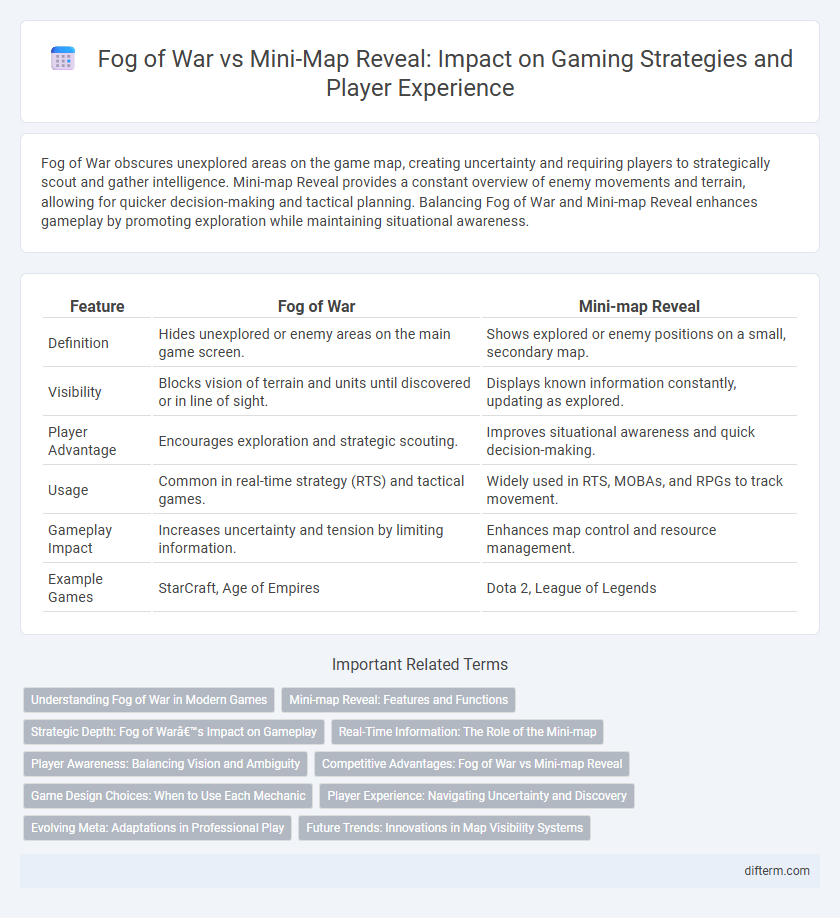Fog of War obscures unexplored areas on the game map, creating uncertainty and requiring players to strategically scout and gather intelligence. Mini-map Reveal provides a constant overview of enemy movements and terrain, allowing for quicker decision-making and tactical planning. Balancing Fog of War and Mini-map Reveal enhances gameplay by promoting exploration while maintaining situational awareness.
Table of Comparison
| Feature | Fog of War | Mini-map Reveal |
|---|---|---|
| Definition | Hides unexplored or enemy areas on the main game screen. | Shows explored or enemy positions on a small, secondary map. |
| Visibility | Blocks vision of terrain and units until discovered or in line of sight. | Displays known information constantly, updating as explored. |
| Player Advantage | Encourages exploration and strategic scouting. | Improves situational awareness and quick decision-making. |
| Usage | Common in real-time strategy (RTS) and tactical games. | Widely used in RTS, MOBAs, and RPGs to track movement. |
| Gameplay Impact | Increases uncertainty and tension by limiting information. | Enhances map control and resource management. |
| Example Games | StarCraft, Age of Empires | Dota 2, League of Legends |
Understanding Fog of War in Modern Games
Fog of War in modern games obscures unexplored or out-of-sight areas, creating strategic uncertainty that challenges player decision-making. Mini-map reveal mechanics complement this by providing limited, partial visibility, often updating dynamically based on units' line of sight or sensor range. Understanding these systems enhances tactical gameplay by balancing information control and player adaptability in real-time strategy and multiplayer genres.
Mini-map Reveal: Features and Functions
Mini-map Reveal in gaming provides players with enhanced situational awareness by displaying enemy positions, objectives, and terrain features in real-time on a compact map interface. Key features include dynamic updates, customizable overlays, and integration with player abilities or intel, allowing for strategic planning and rapid decision-making. This function significantly reduces uncertainty compared to Fog of War mechanics by revealing hidden areas, thus improving tactical advantage and overall gameplay efficiency.
Strategic Depth: Fog of War’s Impact on Gameplay
Fog of War enhances strategic depth by limiting player vision to explored areas, forcing constant scouting and careful decision-making. It introduces uncertainty, increasing the importance of map control and information gathering to anticipate enemy movements. This dynamic aspect contrasts with Mini-map Reveal, which provides static or partial information, reducing the need for adaptive tactics.
Real-Time Information: The Role of the Mini-map
The mini-map provides players with real-time strategic information by revealing enemy positions, terrain changes, and objectives as they become visible, reducing uncertainty caused by the Fog of War. This instant data stream allows for quicker decision-making and more effective unit positioning, enhancing situational awareness throughout gameplay. Fog of War maintains suspense by concealing unexplored or enemy-controlled areas, but the mini-map's constant updates act as a critical tool for tactical advantage in competitive gaming environments.
Player Awareness: Balancing Vision and Ambiguity
Fog of War restricts player vision to create suspense and strategic uncertainty, forcing reliance on limited scouting and careful map control. Mini-map reveal enhances player awareness by providing real-time updates on enemy movements and terrain, reducing ambiguity and enabling quicker tactical responses. Balancing these elements ensures engaging gameplay by maintaining tension without compromising essential situational information.
Competitive Advantages: Fog of War vs Mini-map Reveal
Fog of War creates strategic uncertainty by limiting enemy visibility, forcing players to rely on exploration and reconnaissance for map control. Mini-map Reveal provides constant, real-time intel on enemy positions, enabling faster decision-making and coordinated attacks. The tactical advantage shifts depending on whether players prefer stealth and ambush (Fog of War) or rapid, informed responses (Mini-map Reveal).
Game Design Choices: When to Use Each Mechanic
Fog of War enhances strategic depth by limiting player vision to areas explored or within unit sight, promoting tactical decision-making and surprise elements in real-time strategy games. Mini-map Reveal offers constant, simplified awareness of enemy positions or objectives, useful in fast-paced or action-oriented games where quick reactions are essential. Choosing between these mechanics depends on the desired balance between realism, player engagement, and game pacing in the design process.
Player Experience: Navigating Uncertainty and Discovery
Fog of War enhances player immersion by limiting visibility to explored areas, creating tension and strategic decision-making during navigation. Mini-map Reveal provides real-time spatial awareness, reducing uncertainty and enabling quicker responses to threats or opportunities. Balancing these mechanics influences player engagement by blending exploration excitement with tactical clarity.
Evolving Meta: Adaptations in Professional Play
Professional gaming strategies constantly evolve as players adapt to the challenges posed by Fog of War and Mini-map Reveal mechanics. Teams leverage advanced map control, vision denial, and information gathering to outmaneuver opponents, optimizing resource allocation and positioning. The dynamic meta highlights the significance of real-time intelligence and deception techniques, redefining competitive play across titles like League of Legends and Dota 2.
Future Trends: Innovations in Map Visibility Systems
Future trends in map visibility systems in gaming emphasize integrating AI-driven Fog of War mechanics with dynamic mini-map reveals to enhance real-time strategic decision-making. Advances in machine learning enable adaptive visibility that reflects player behavior and environment changes, creating immersive and personalized gameplay experiences. Hybrid systems combining 3D spatial data and augmented reality overlays are set to redefine map interaction, improving situational awareness and tactical precision.
Fog of War vs Mini-map Reveal Infographic

 difterm.com
difterm.com